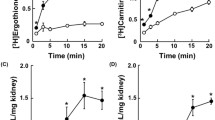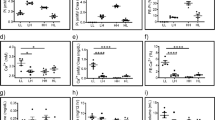Abstract
In order to study the specificity for contraluminal para-aminohippurate (PAH) transport, the inhibitory potency of aliphatic dicarboxylates on3H-PAH influx, as well as the inhibitory effect on35SO 2−4 - and3H-succinate influx, from the interstitium into cortical tubular cells in situ has been determined. The following was found:
-
1.
Testing a homologous series of dicarboxylates-ranging from the 2 C oxalate to the 10 C sebacate — PAH transport was inhibited by succinate (app.K i 1.35 mmol/l), and all longer dicarboxylates, with high potency (app.K i 0.05–0.35 mmol/l). Sulfate transport was inhibited only by oxalate (app.K i 1.1 mmol/l), while dicarboxylate transport was inhibited by succinate, glutarate, adipate and pimelate with decreasing potency (app.K i 0.04, 0.24, 0.91, 4.0 mmol/l, respectively).
-
2.
PAH transport was inhibited by succinate and glutarate with high potency (app.K i 1.35 and 0.05 mmol/l), by the correspondent monomethylester to a lesser extent (app.K i 1.7 and 0.74 mmol/l), but not by the dimethylester. On the other hand, the semialdehyde of succinate with aK i-value of 1.2 mmol/l, had the same inhibitory potency as succinate itself, while the dialdehyde of glutarate (app.K i 1.4 mmol/l) was much less potent as glutarate.
-
3.
Introduction of an oxo-, methyl- or sulfhydroxylgroup onto the 2-position of succinate, or of an oxo-group onto the 2-position of glutarate moderately augmented the inhibitory potency against PAH-uptake. However, introduction of a 2-hydroxy group onto succinate or glutarate in thel-position reduced the inhibitory potency more than in thed-position. Introduction of two methyl-, sulfhydryl- or hydroxyl-groups in the 2–3-position of succinate reduced or abolished its inhibitory potency. The introduction of a 2-amino group onto succinate or glutarate abolished its effect on PAH transport. However, N-acetylation or N-benzoylation led to a restitution in inhibitory potency.
-
4.
The trans-isomers fumarate and mesaconate inhibited PAH- and methylsuccinate transport, while the cis-isomers maleate and citraconate did so to a lesser extent or not at all. The effect was reversed with the tricarboxylic aconitates, because cis-aconitate bears a CH2-extended COOH-group in trans-position and trans-aconitate in cis-position.
The data indicate that there exist three different anion transport systems at the contraluminal cell side of the proximal renal tubule: 1. a sulfate-oxalate transporter, 2. a sodium-dependent dicarboxylate transporter, and 3. a paraaminohippurate transporter. The PAH transport system accepts dicarboxylates with chain length higher than 7.5 Å (=distance between the terminal oxygen atoms), while the dicarboxylate transport interacts with dicarboxylates with a chain length between 6.5 and 10 Å. Both transport systems prefer the transconfiguration. The effect of side groups on the interaction of dicarboxylates with the PAH-transport system is due mainly to hydrophobicity and electron configuration.
Similar content being viewed by others
References
Burckhardt G (1984) Sodium-dependent dicarboxylate transport in rat renal basolateral membrane vesicles. Pflügers Arch 401:254–261
Cornish-Bowden A (1986) Why is uncompetitive inhibition so rare? A possible explanation with implications for the design of drugs and pesticides. FEBS Lett 203:3–6
Cross RJ, Taggart JV (1950) Renal tubular transport: accumulation of p-aminohippurate by rabbit kidney slices. Am J Physiol 161:181–190
Despopoulos A (1965) A definition of substrate specificity in renal transport of organic anions. J Theoret Biol 8:163–192
Fritzsch G, Haase W, Rumrich G, Fasold H, Ullrich KJ (1984) A stopped flow capillary perfusion method to evaluate contraluminal transport parameters of methylsuccinate from interstitium into renal proximal tubular cells. Pflügers Arch 400:250–256
Hansch C, Leo A, Unger SH, Kim KH, Nikaitani D, Lien EJ (1973) “Aromatic” substituent constants for structure-activity correlations. J Med Chem 16:1207–1216
Hewitt WR, Clark RL, Hook JB (1976) Investigation on metabolic modulation of p-aminohippurate accumulation by rabbit renal cortical slices. J Pharmacol Exp Therap 199:498–509
Kippen I, Klinenberg JR (1978) Effects of renal fuels on uptake of PAH and uric acid by separated renal tubules of the rabbit. Am J Physiol 235:F137-F141
Löw I, Friedrich T, Burckhardt G (1984) Properties of an anion exchange in rat renal basolateral membrane vesicles. Am J Physiol 246:F334-F342
Møller JV, Sheikh MI (1982) Renal organic anion transport system: pharmacological, physiological and biochemical aspects. Pharmacol Rev 34:315–358
Reference deleted
Ullrich KJ, Fasold H, Rumrich G, Klöss S (1984) Secretion and contraluminal uptake of dicarboxylic acids in the proximal convolution of rat kidney. Pflügers Arch 400:241–249
Ullrich KJ, Rumrich G, Fritzsch G (1984) Contraluminal sulfate transport in the proximal tubule of the rat kidney. I. Kinetics, effects of K+, Na+, Ca2+, H+ and anions. Pflügers Arch 402:264–271
Ullrich KJ, Rumrich G, Klöss S (1985) Contraluminal sulfate transport in the proximal tubule of rat kidney. III. Specificity: disulfonates, di- and tri-carboxylates and sulfocarboxylates. Pflügers Arch 404:300–306
Ullrich KJ, Rumrich G, Fritzsch G (1987) Contraluminal paraaminohippurate transport in the proximal tubule of the rat kidney. I. Kinetics influence of cations, anions and capillary preperfusion. Pflügers Arch (in press)
Author information
Authors and Affiliations
Rights and permissions
About this article
Cite this article
Ullrich, K.J., Rumrich, G., Fritzsch, G. et al. Contraluminal para-aminohippurate (PAH) transport in the proximal tubule of the rat kidney. Pflugers Arch. 408, 38–45 (1987). https://doi.org/10.1007/BF00581838
Received:
Accepted:
Issue Date:
DOI: https://doi.org/10.1007/BF00581838




